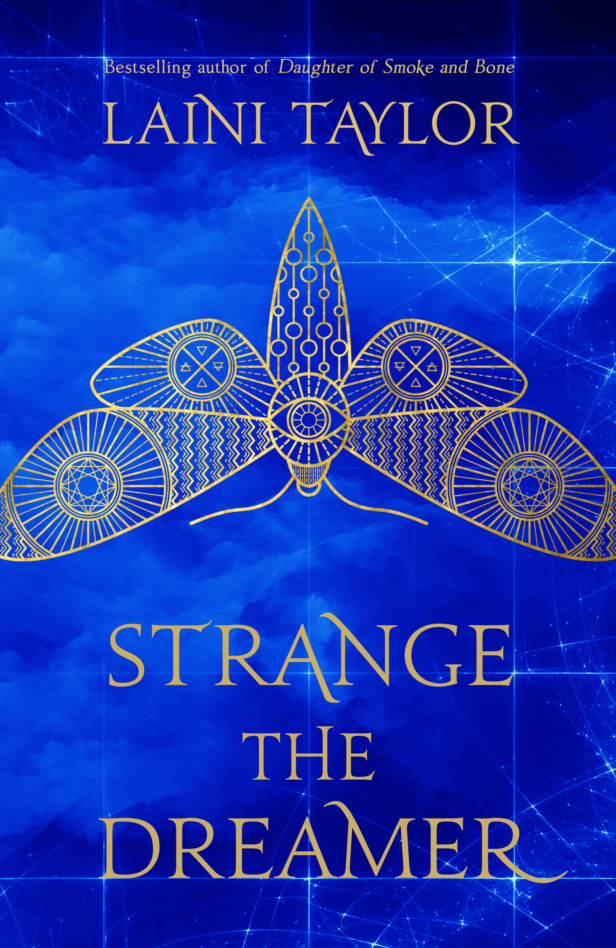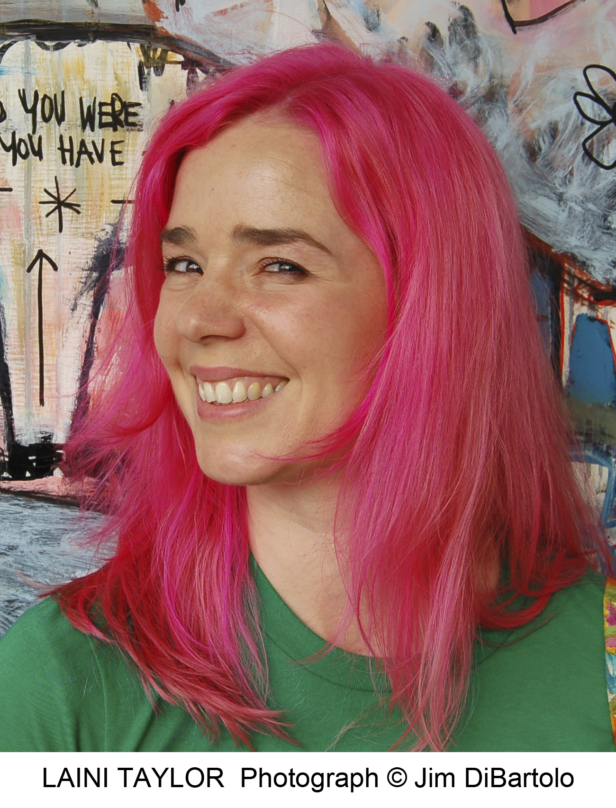Following the incredible Daughter Of Smoke And Bone trilogy, Laini Taylor is back with the first instalment in a new fantasy world: Strange The Dreamer. The book is the story of Lazlo Strange, a boy who has grown up fascinated by the tales of the lost city of Weep and who jumps at the chance to join the band setting out to liberate it. It’s an incredible journey, and it’s far from safe…
We talked to Taylor about how Strange The Dreamer came to be, leaving one fantasy world for another, and why fantasy readers do it better…
How would you pitch Strange The Dreamer to a potential reader?
Ahhh! I can’t seem to write books that are easily described. I suppose I would say that it’s about a young librarian, a mythic lost city, the surviving children of murdered gods, and how we pick up the pieces and carry on after violence. With moths and ghosts. And cake.
How did this story first come about? Was it the world, the character of Lazlo?
The first piece of the puzzle was Sarai, actually. The book was meant to be hers. She’s been in my head for some twenty years: this lonely nocturnal young woman who lives in a tower, high above a city, and who is responsible for sending nightmares to the citizens below. That idea meshed with another, about children who survived a massacre of gods, and a story began to take shape. I was six or seven months into writing it though and I kept starting over. I think I wrote some thirty first chapters, many of which I really loved, but I could tell they weren’t setting up the story I wanted to tell. It was brutal. Finally, one day I had a revelation. I was writing about Lazlo (then a secondary character), trying to get to know him, when I wrote the line, “his nose was broken by a falling volume of fairy tales when he was a boy,” and just like that, I knew: he was actually the hero of this story. After that, things began to fall into place.
When you’re creating a fantasy world, what’s the first thing that you want to get right, to really nail down right at the start?
No matter what the world, the characters are always the foundation. When I was a young writer (I mean pre-teen young), “writing” to me meant worldbuilding, full stop. I created these epic worlds and drew maps of them, and peopled them with gods and kings and witches, but I never wrote any stories that actually took place in them! It was pure worldbuilding. That’s an excellent strategy for never writing book, and it worked for me for years: I never wrote a book until I was 35. In the process of finally learning how to do this important storytelling thing, I discovered that it’s all about the characters: creating a compelling situation, and putting them in it. The worldbuilding is secondary; it has to serve the story. So now, however much I still enjoy all the fabulous trappings of fantasy, I don’t let myself get too carried away at the beginning. I try to know enough to get started, and to let the rest develop along with the narrative, depending on what I need.
Is it difficult to leave a series behind and start something new, or is it kind of refreshing to have a blank canvas?
Refreshing! I’d been working on the Daughter Of Smoke & Bone books for about five years, and there were so many other stories in my head, milling about, waiting to get out and stretch, that it was fabulous to start something new. Also, it was such a dash to the deadline (shut into a cabin alone for a week and not quite finishing, and so shut in a hotel for more days and finally writing for 23 hours straight to make it to “the end”!!) that relief at having made it, combined with exhaustion, overshadowed everything else. Later, though, I began to miss Karou and everyone, and to daydream a little about writing stories or novellas set in their world just to spend more time with them. I imagine I will, when I can find the time. And it’s a possibility though not a certainty that one day I will return to them to write the epic battle with the Nithilam as a new book or series.
What was it like seeing the incredible reader reaction to A Daughter Of Smoke And Bone?
It was a dream. It wasn’t my first book, but my fourth, so I was well aware by then what a normal book launch feels like, and I was very ready to appreciate the beautiful and exciting reception of Daughter Of Smoke And Bone! My earliest sense that this was going to be a different experience was probably at the sales conference in London, when my publisher, Hodder & Stoughton, outfitted the Café de Paris nightclub like Brimstone’s shop, and hired costumed actors and even put me in costume with horns and everything. That was my “Toto we’re not in Kansas anymore” moment!
When I started out writing Daughter, it was as a side project for pure fun, to try to recapture the joy of writing that had deserted me on a different book. It worked. I was writing a book I wanted to live in, more or less as a gift to myself (both my teen and adult self), and I think that’s what readers have responded to: the pure wish fulfillment of it all. It’s been intensely gratifying.
Are you conscious of who the reader is going to be when you’re writing (YA, genre fan..) or do you have to focus purely on the story as it comes to you?
Primarily I’m trying to please and captivate myself, with the hope that enough other readers share my taste that they will be pleased and captivated too, and the book will find an audience! That said, I never lose sight of the fact that a large percentage of my readers are young. It doesn’t affect my prose or style or even subject matter, but it does color the way I depict certain things like sex and violence. Young readers are still constructing their perception of the world and relationships, so I feel a certain responsibility to not feed them garbage, so to speak. I’ve got a piece of an adult manuscript written, and the treatment of sex, for example, is quite different. There are no set rules to follow; it’ll be different for every writer.
As for whether I consider the “genre-ness” of readers…not really. It was happy chance that Daughter Of Smoke & Bone, by starting out grounded in the real world, lures in non-fantasy readers by existing in their comfort zone before transporting them to more fantastical realms. “I don’t read fantasy but I love your books” is something I hear all the time, and I’m thrilled if I can convert anyone to SFF, but I’m not thinking about it when I write. I realized after writing Strange the Dreamer that one of it’s major themes could be summed up as “Fantasy readers do it better,” and that it’s a celebration of the superior minds—and hearts—of fantasy readers!
Have you always been drawn to fantasy stories?
Yes and then no and then yes again! Fantasy books made me a reader and a writer at a young age, but then in my teens I shifted away to “literature,” and thought myself quite sophisticated for a number of years for reading only non-magical books by dead men. Not to cast aspersions on non-magical books by dead men, but they sort of redecorated my mind, boxing up all the most interesting furniture and art (and caging up the dragons), in favor of a more subdued palette of…realism. And my creative mind in those years was not a terribly inspired or inspiring place. When I tried to write, I didn’t get anywhere. I remember being, like, 23, and feeling like I was on one side of a door and all of life experience and insight were on the other side. In the realm of realism, I had very little to say. It wasn’t until I rediscovered fantasy in my mid-twenties that I let the dragons out of their cages and things got fun again. Thank god.
Was there one author or book that was a genre gateway for you growing up?
Not really, at least not that I recall. I think I segued seamlessly from fairy tales and mythology into fantasy novels. I loved Daulaire’s Norse Gods & Giants and the stories of George MacDonald, and then I loved Anne McCaffrey and Madeleine L’Engle and just kept going. After my long excursion into “literature,” the book that brought me back to fantasy in my 20s was Harry Potter, which also reopened the door for me to youth fiction and happily led the way to Philip Pullman, Garth Nix, and many more.
Which author are you particularly excited about at the moment?
Some longtime favorites are Francis Hardinge, Elizabeth Knox, Patrick Rothfuss, James SA Corey, Leigh Bardugo—and I was very excited to hear about Philip Pullman’s forthcoming Book of Dust trilogy! Some new voices I’m excited about are Sabaa Tahir, Roshani Chokshi, Lana Popovic, and Anna-Marie McLemore.
What are you working on next?
I’m writing the sequel to Strange The Dreamer. It’s called The Muse Of Nightmares, which was what the first book was going to be called before Lazlo took over as main character. It picks up where Strange left off, and delves into the mystery of the Mesarthim, where they came from, and what the hell they did with all those children for two hundred years.
Strange The Dreamer by Laini Taylor is out now from Hodder & Stoughton. Keep up with the latest genre news with the new issue of SciFiNow.

